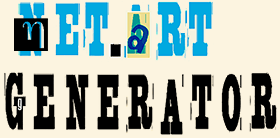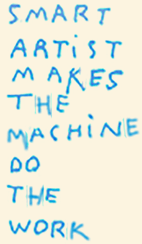Totally Automatically a Genius
Verena Kuni
generator. latin root, generatus. god as generator of the world and god as creator of human beings. the analogy of the deus artifex corresponds to that of the artist creating his works like a god, an image that has returned again and again since
the renaissance. to briefly outline this function would mean saying that the makeup of the autonomous individual as the apotheosis of the human being is justified up to the point at which such individuals, as homo creator, as an artist approaches
the position of a god. in both forms, the original act of creation is bound to its inevitable consequence, the transformation into a serial product. But serial processes are a distinguishing characteristic of the modern.
artists usually buy a mac when they want to work digitally. it can be counted as a loss if the resistant material on which artistic efforts are focused dissipates in on-screen images. but net.art only works on the net and chooses the net or the
myth of the net as its theme. the idea is fundamental, although at the same time, doubtful without a medium-specific translation and without the participation of others. but when the event of its form of reproduction becomes more important
socially than it is in its original form, then the original must be made with consideration for its reproduction. nevertheless, all net.art projects may be traced back to a single origin, or in other words: to an author. the stagnation of the
world in ongoing repetition of the same is the guarantee of immortality for its initial motivator. what would be left of the idea based on an individual artist when it comes to the collaboration of many remains unforeseeable.
the essay you just have read is probably completely meaningless and was randomly generated by a text generatrix. to generate a piece of net.art follow this link: http://net.art-generator.com
Well. The recommendation holds. The text that precedes it, though, may seem not to offer much in the way of meaning at first glance - which can be a bit irritating when one considers that more than the surreal poetry of meaningless chains of
syllables or words can now be expected of cleverly programmed generators: Namely, veritable net.art of timeless truth, beauty and good.
So did it perhaps have something to do with the original material? Hopefully not: Because the ode to the net.art.generator was indeed only half-automatically generated – on the one hand, from texts aiming seriously and with a notable effort
towards meaning to address the topic of authorship and the genius of the artist, and on the other hand, from similar texts addressing art on the net. All these texts, taken on their own, make coherent arguments – whether or not one shares their
viewpoints. The loss of this clarity, even though central arguments have been quoted, is due less to blind arbitrariness than to the intent of pointing to problems of compatibility of a fundamental nature via data compression; problems which, due
to the structures of art operating system and their historical roots, arise when programs are supposed to run on them that are invested with certain utopias of net culture in general – and especially those that aim to see here a completely new
art form bloom within in which, instead of a self-enclosed art work legitimized by the signature of the artist as his brilliant creation, suddenly a sort of digital "social sculpture". Immaterial and, as with all that is spiritual or intellectual
in art, bordering on the transcendental – but part of pop culture nonetheless; "interactive", of course (that's very important), open and accessible - but in no way trivial. Endlessly reproducible – but please, not only original as well, but
also, somehow, an original. Immediately understood as ingenious. Only: If everyone is to be a net.artist, how does one sell oneself as a unique artist?
In short: The little text was the result of a collision of swirling streams of data that had already been generated by others. Brought and set together by a generator who in this case was not creating net.art, but rather, a contribution to a
catalogue on the net.art.generator by the artist Cornelia Sollfrank. *1 Whether the rules of art by which such monographic appreciations tend to be written have been broken can be set aside for the moment. Cryptic chains of words looking
suspiciously like they bear theoretical depth while nodding to a few impactful key terms are actually part and parcel of most respectable monographs. All that's clearly missing from this text are the obligatory acknowledgements of the life and
works of the artist. That absence might be attributed to the theme and means of functioning of the work which ultimately just as elegantly as clearly leads the answer to the question of the authorship of the artist to those called upon to be
co-creators and then to program of the net.art.generator as it is set in motion. But only to have it implicitly lead back to the initiator of the entire process: "A smart artist makes the machine do the work". In view of this motto, which has
long been the text in Sollfrank's email signature file - even if one includes in the calculations the participating programmers *2 called upon and directed by the generator of the generator -in the end, the primacy of the "idea", the concept,
remains. And the artist's signature.
What this movement means can be better understood when one examines the context in which its carried out a bit more closely: The area of tension in which the debates concerning the previously mentioned problems of compatibility between the
utopias of net culture and the realities of the "art operating system", debates which have shaped reception of the phenomenon of net.art for some time - and on the producing end as well as the reception end. A field, then, which has proven itself
to be, at times more, at times less a "smart net.art.history.generator". There is no space here to approach this context even closer,and so, at this point, one can only refer briefly to texts that would lead further. *3 But that might be just
fine. After all, this book should accomplish what a "respectable monograph" of the old school aims to: Namely, to be a "(net.)art.history.generator". The focus is on the artist and her work, and the context in this case can be frames within
frames. One would have to leave a continuation and expansion of this "framing" to following publications. And - one assumes - to Sollfrank herself.
*1 For the publication accompanying the exhibition Serialität: Reihen und Netze (Seriality: Rows and Nets), Städt. Galerie, Bremen November 7 - December 5, 1999.
*2 Ryan Johnston (nag_01); Luka Frelih (nag_02); Barbara Thoens and Ralf Prehn (nag_03).
*3 Cf. Verena Kuni: Der Widerspenstigen Zähmung. Webbasierte Kunst im etablierten Ausstellungsbetrieb. In: Kunst-Bulletin, Nr. 11, November 2001; Verena Kuni: Die Legende vom Netzkünstler. In: Borderline. Strategien und Taktiken für Kunst und
soziale Praxis, Reader zum Kongress, Wiesbaden 2002; What is a net.artist? On the uses and disadvantages of the legend of the artist in the era of its techno-logical reproducibility, From Work to Word, Eds. Doris Frohnapfel, Bergen/No &
Köln 2002; Why have there been no great cyberfeminist net.artists?, Nutzen und Nachteil der Legende von der Cyberfeministischen Netzkünstlerin (to appear in print in the protocol of the Art Historians Meeting 2002, Eds. Susanne von
Falkenhausen/Silke Förschler/Ingeborg Reichle/Bettina Uppenkamp, Marburg 2004).

